A self-study, self-paced course where you can learn how to paint in watercolor by watching video lessons and doing assignments
$297 USD
ENROLL NOWA self-study, self-paced course where you can learn how to paint in watercolor by watching video lessons and doing assignments
$297 USD
ENROLL NOWOne-to-one, unlimited and custom-tailored to your skills and needs Personal Tutoring by the Watercolor Academy teachers
$997 USD
ENROLL NOWMonochrome Portrait by Natalie Richie
In this video lesson, you will discover how to make a monochrome portrait using the wash and outline technique.
Here is the artwork that Natalie Richie will produce by the end of this video lesson.
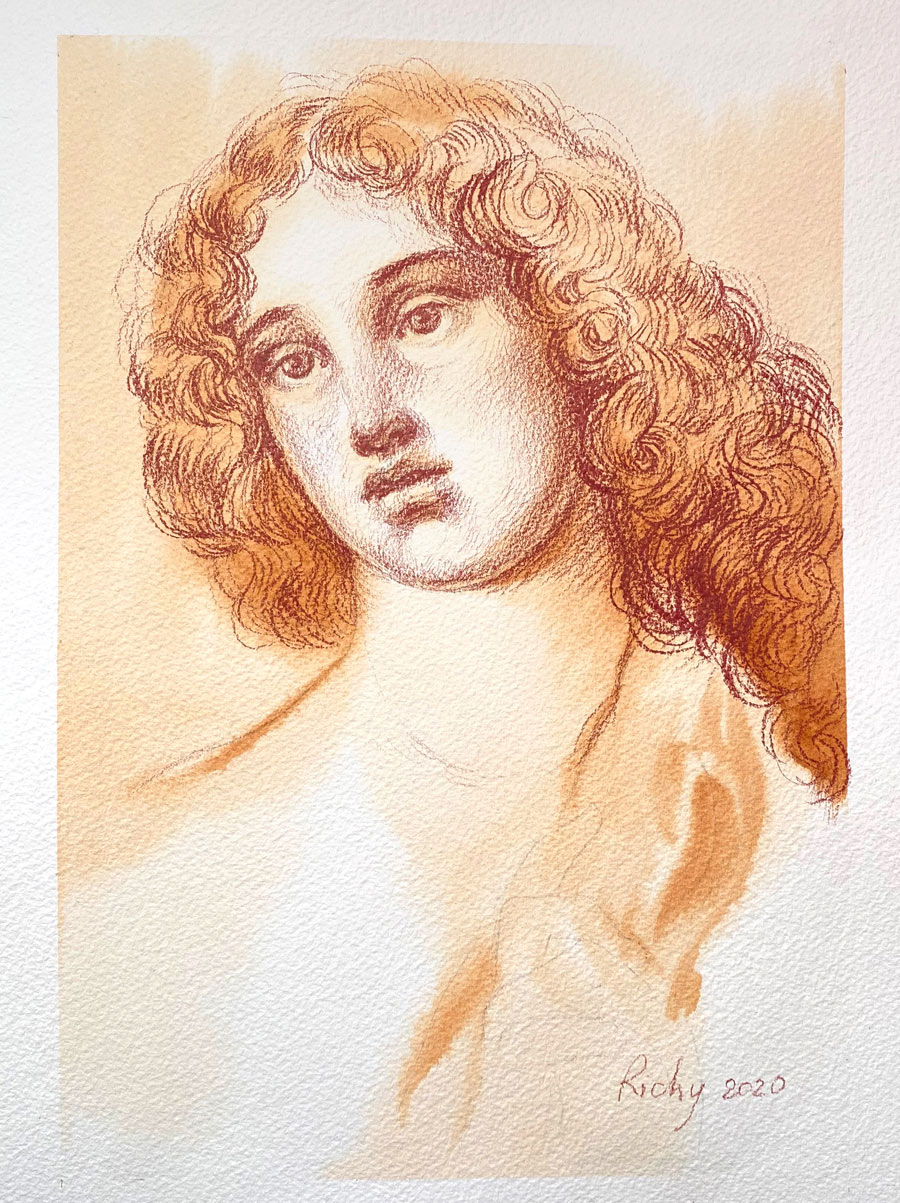
This portrait sketch was done as a preliminary drawing for a multifigure painting in oil, which Natalie created using the indirect oil painting method developed by the Old Masters.
If you would like to learn how to paint in oil like the Oil Masters using modern materials, you will find the Old Masters Academy course to be very helpful. In this course, you will learn almost forgotten oil painting techniques that are no longer taught in contemporary art colleges.
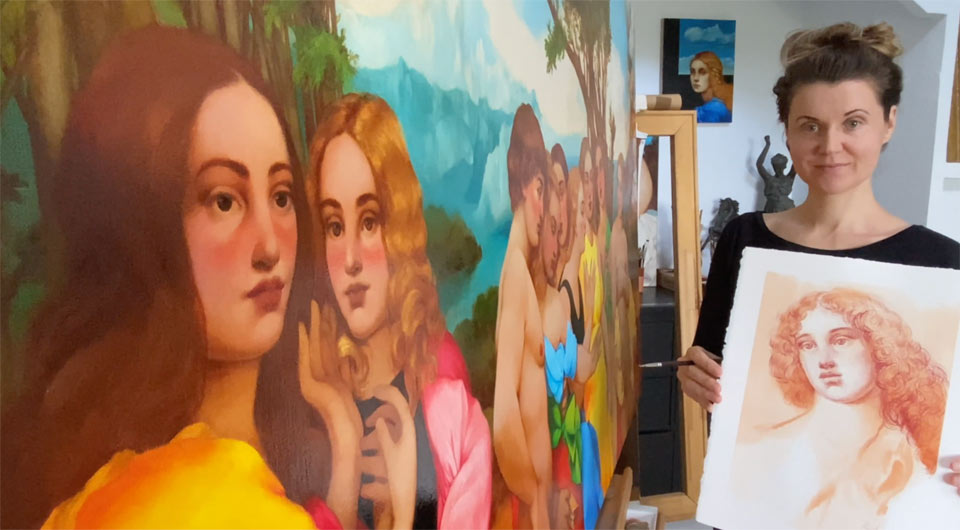
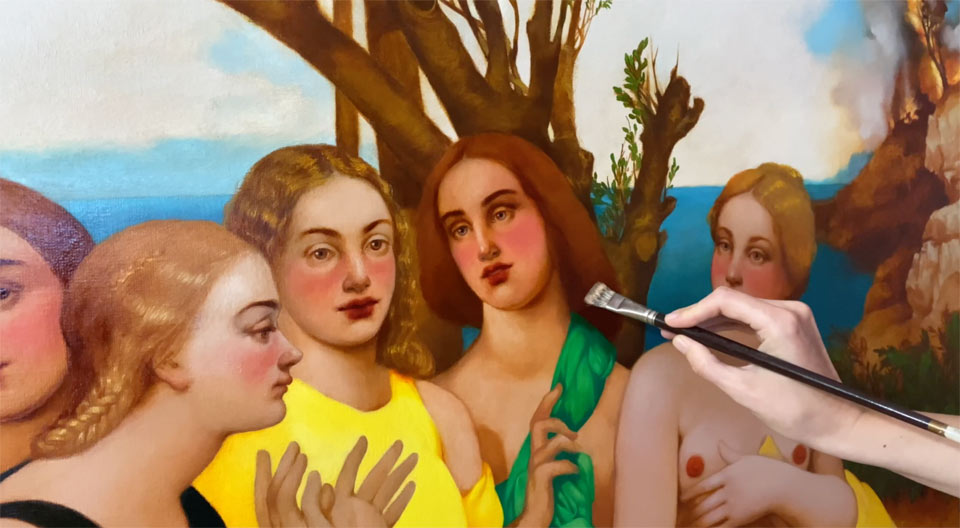
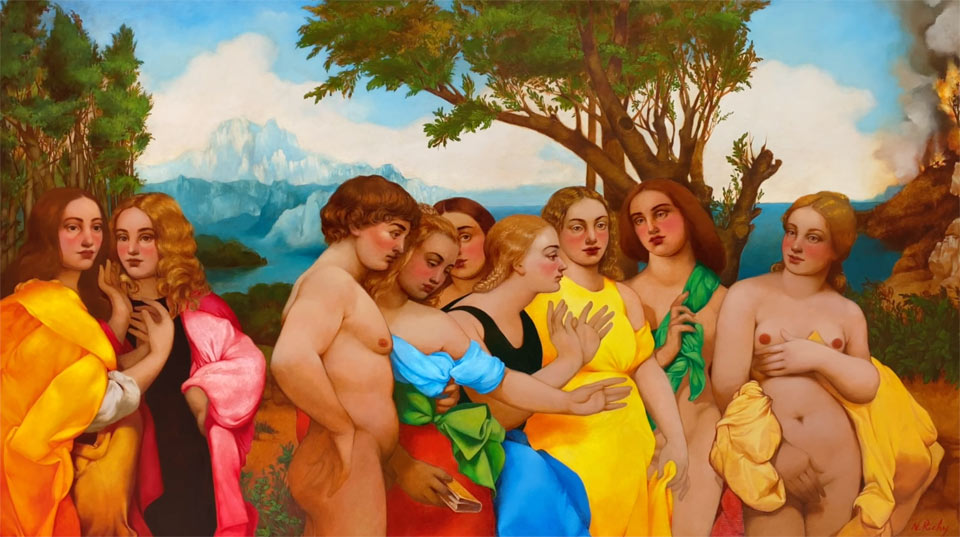
To begin this artwork, the portrait outlines have to be transferred onto the watercolor paper. For this purpose, Natalie has done the sketch on tracing paper, fixed it to the watercolor sheet and now she is outlining this sketch once again to transfer it onto the watercolor paper sheet. From time to time, the tracing paper can be flipped open to check the quality of this transfer.
With the portrait sketch in place, it is time to prepare the paint mix. The Burnt Sienna paint from Windsor & Newton will be the only watercolor paint that Natalie will use in this artwork. Burnt Sienna has a rich brown color, is transparent, and has excellent permanence. A sufficient quantity of the mix has to be prepared for the wet-into-wet wash. The watercolor paper sheet also has to be prepared for such a wash, so its face surface is moistened with clean water, which is applied with a soft flat brush, making sure that there are no dry places left.
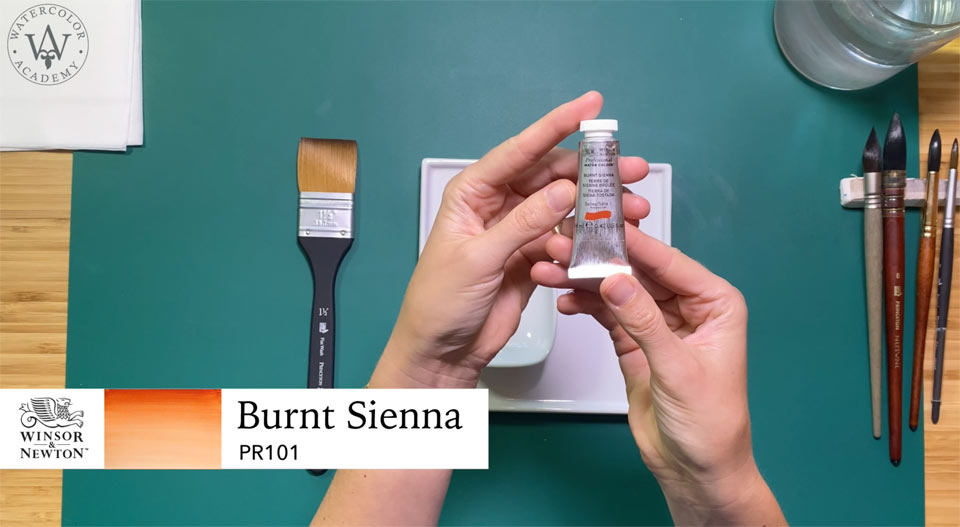
This is rough, 100% cotton paper, which expands when wet, creating hills and valleys. However, this fine because when the paper dries, it will shrink down and the hills and valleys will not affect the wash much. Because this is done with a moist mop brush, the paint does not flow uncontrollably from the hills into the valleys. The only purpose of this wash is to make a monochrome background for a portrait artwork.
The brown pigment is applied with loose brush stroke, without too much attention to the precision of borders and outlines. You may see that even the facial features are indicated very approximately with a big soft round brush. Without an under-drawing, this artwork would not look like a portrait at this step. So far, it is a collection of random light brown spots.
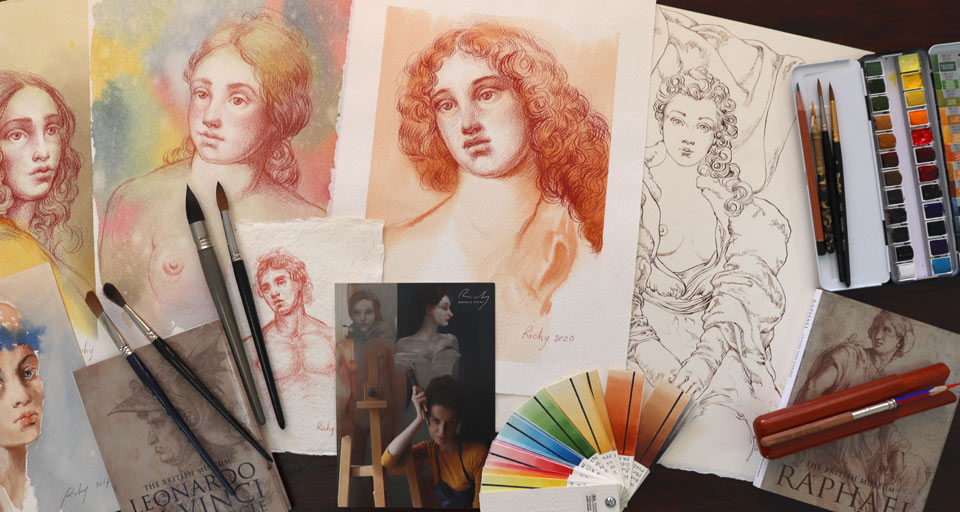
The rules of making such an underpainting are quite simple. Paint is applied wet-into-wet to achieve soft borders of brushstrokes, light areas of an artwork should be left unpainted, and tonal values can be built gradually by adding more pigment into dark areas while they are wet. It is more important to define big masses, rather than concentrate on small details. The facial features can be depicted very schematically, and it is better to under paint them than to over paint them. It is also preferable to keep all tonal values a bit lighter than they will be in the finished artwork. And finally, it is better to underdo the preparation of watercolor paint than to overdo it. When the underpainting is done, it has to be left to fully dry before continuing with the second part of this artwork, which requires drawing a portrait in a colored pencil. The pencil color can be of your choice, for example, a dark red or brown, which you can test in order to see how it looks on a watercolor paper sheet. The second step of this artwork is not painting, but drawing, making this a combination of watercolor paint with colored pencil, and therefore a 'mixed media artwork'.
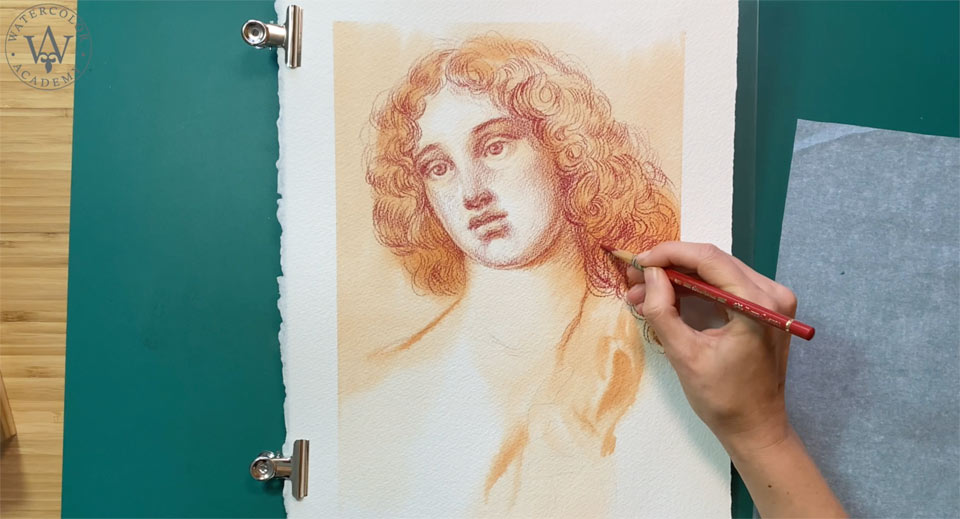
A good painting is well-drawn. In this case, this is applicable literally, because all details of this portrait will be drawn with a pencil, on top of a watercolor underpainting. There are many things that an artist should know to be able to draw realistic and believable portraits, including a human head anatomy, the proportions and alignments of a human head and face, the know-how of drawing facial features, and how to render good tonal values the right way.
If you would like to learn how to draw beautiful portraits from life, memory and imagination, there is one online academy where you can do this in a fast and easy way. Life Drawing Academy has two courses. In the online course, which is a self-paced, self-study course, you can learn how to draw portraits and figures, by watching 52 video lessons, in the comfort of your home. In this course, you will receive a lifetime membership and can study at your pace; as a Life Drawing Academy Online Course student, you can also rely on unlimited personal support from the Academy tutors. This support includes your artworks critique, answers to your art questions, and advice on how to improve your life drawing skills. Such support is unlimited and comes at no extra charge.
However, if you learn better under the guidance of art teachers, there is one opportunity that you do not want to miss: you can get personal, one-to-one tutoring which will be custom tailored to your level of skills, and will help you to achieve your art education goals. Such personal tutoring is available within the Life Drawing Academy Correspondence Course. In this course, you will still take all 52 video lessons, but above all, you will be guided step-by-step by Academy tutors to complete the course curriculum. To make this curriculum for you, Academy tutors will first assess your current level of drawing skills, will give you a full comprehensive report, and will advise you as to which skills you are missing, and which topics you need to cover to improve your drawing skills to the advanced level. You will be given up to 100 drawing tasks, one-by-one, together with a detailed explanation of how to do them, and every task result will also be thoroughly assessed and advice will then be given to you on how to further improve your drawing skills.
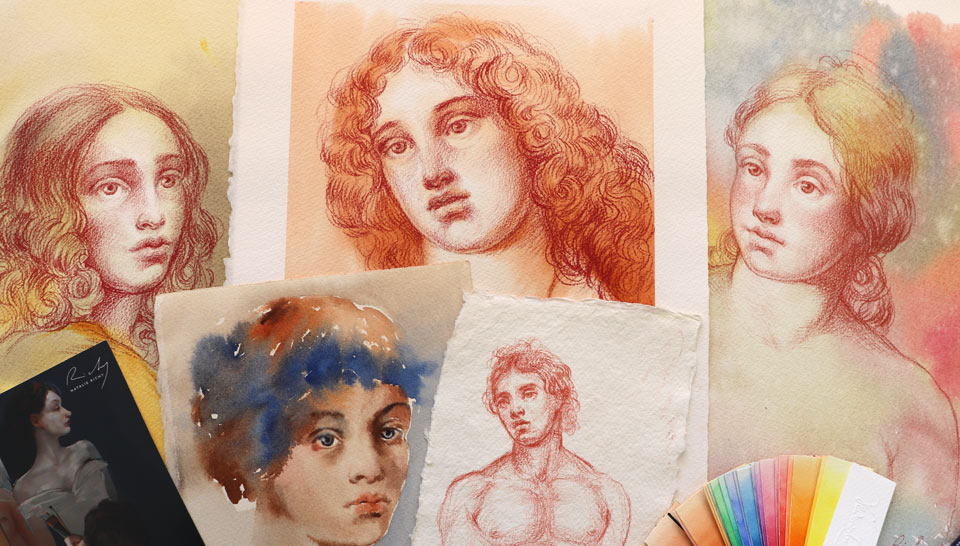
With the Life Drawing Academy, tutoring will be at your pace. There are no deadlines and no time limits. There is no way for you to fail. The Life Drawing Academy Correspondence Course is not only about portraits and figures. If you have any skills gaps on: how to hold a pencil, how to render tonal values, how to draw in perspective, how to use the golden proportions, how to make good compositions and so on, all such skills gaps will be addressed. Furthermore, special drawing tasks will be included into your personal curriculum, so that you can become a better artist by following it. Because a very special curriculum will be created and tailored just for you, the Life Drawing Academy correspondence course is perfectly suited for complete beginners. Even if you have never drawn a simple cube in perspective, not to mention a fully rendered realistic portrait, this course is for you.
However, even advanced art students will find this course to be greatly helpful, because for these students, different topics will be included in the curriculum. For example, how to depict emotions in portraits, how to draw dynamic figures in motion, how to make beautiful multifigure compositions, and so on. The Life Drawing Academy is truly unique. You will not find such a course anywhere else. In this Academy, you will learn from professional artists and art tutors, who teach the same drawing techniques as those taught in the best Russian art academies.
To get the same quality of art education, you would have to learn Russian and relocate to Moscow, or Saint Petersburg, for several years. However, as a Life Drawing Academy student, you will receive a lifetime membership and be able to study at your own pace and in the comfort of your home, under the personal guidance of Academy teachers.
A self-study, self-paced course where you can learn how to paint in watercolor by watching video lessons and doing assignments
One-time payment - Lifetime membership
$297 USD
One-to-one, unlimited and custom-tailored to your skills and needs Personal Tutoring by the Watercolor Academy teachers
One-time payment - Lifetime membership
$997 USD